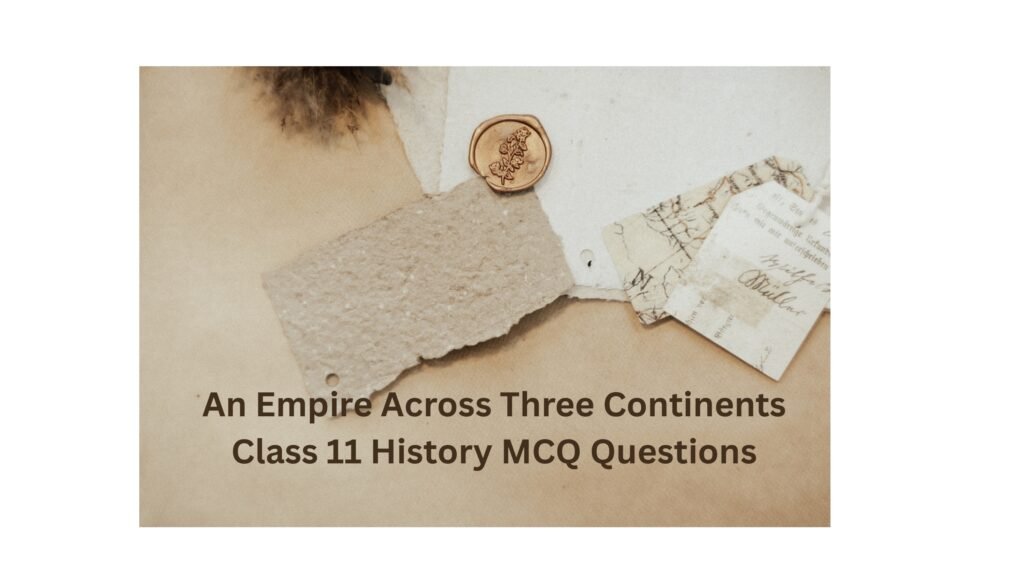An Empire Across Three Continents
“Sharpen your understanding of ancient civilizations with Class 11 MCQs on ‘An Empire Across Three Continents’. Test your grasp on trade, governance, and Roman history through well-structured questions designed to enhance retention and boost your History exam performance.”
Q 1 – The best kind of wine came to Rome from _______
(a) Fayum
(b) Byzantium
(c) Galilee
(d) Campania
(d) Campania
Q 2 – The Roman emperor who consolidated the rise of provincial upper classes so as to exclude the senators from military command was
(a) Augustus
(b) Constantine
(c) Gallienus
(d) Tiberius
(c) Gallienus
Q 3 – What were Amphorae?
(a) A type of army
(b) A type of container
(c) A type of district administrator
(d) None of the above
(b) A type of container
Q 4 – Augustus, the first Roman Emperor was called the leading citizen whose Latin term is
(a) Basileus
(b) Dominus
(c) Princeps
(d) Res gestae
(c) Princeps
Q 5 – Saint Augustine was bishop of the North African city of
(a) Annaba
(b) Algeria
(c) Hippo
(d) Numidia
(c) Hippo
Q 6 – The emperor who made Christianity the official religion in the Roman Empire was
(a) Alexander
(b) Augustus
(c) Constantine
(d) Nero
(c) Constantine
Q 7 – Roman ruler _____ was considered as the leading citizen only to show that he was not the absolute ruler.
(a) Augustus
(b) Constantine
(c) Gallienus
(d) Tiberius
(a) Augustus
Q 8 – In Roman urban life, the entertainment shows called spectacular happened for at least
(a) 150 days
(b) 160 days
(c) 167 days
(d) 176 days
(d) 176 days
Q 9 – The Roman Empire got the best kind of wine from the city of
(a) Byzaciuma
(b) Campania
(c) Naples
(d) Sicily
(b) Campania
Q 10 – The Roman silver coin, known as the denarius, weighed _________ gm of pure silver.
(a) 2
(b) 3
(c) 4
(d) 5
(c) 4
Q 11 – ______ and Greek languages were used in the administration of the Roman Empire.
(a) Chinese
(b) Mayan
(c) Latin
(d) Turkish
(c) Latin
Q 12 – Which one of the following is a rive that forms the boundary of the Roman Empire?
(a) Mekong River
(b) Rhine River
(c) Amur River
(d) Yangtze River
(b) Rhine River
Q 13 – The Ostrogoths established their kingdom in Italy in the year
(a) 493 CE
(b) 494 CE
(c) 495 CE
(d) 496 CE
(a) 493 CE
Q 14 – The religion of Islam arose during the
(a) 5th century CE
(b) 8th century CE
(c) 6th century CE
(d) 7th century CE
(d) 7th century CE
Q 15 – The ______ System of the Roman Empire was the system of government in which the real power vested in the Senate.
(a) Democrat
(b) Republican
(c) Maoist
(d) Marxist
(b) Republican
Q 16 – Augustus, the first Roman Emperor was called the ‘leading citizen’ whose Latin term is
(a) ‘Basileus’.
(b) ‘Dominus’.
(c) ‘Princeps’.
(d) ‘Res gestae’.
(c) ‘Princeps
Q 17 – Christianity became the state religion of Roman Empire in the
(a) 1st century CE.
(b) 2nd century CE.
(c) 3rd century CE.
(d) 4th century CE.
(d) 4th century CE.
Q 18 – The Roman silver coin, known as denarius, weighed _________ gm of pure silver.
(a) 2½
(b) 3½
(c) 4½
(d) 5½
(c) 4½
Q 19 – Fill in the blanks
1.When we talk about writing or a script, we mean that spoken sounds are represented in …………….
2. Regular exchanges are possible only when there was a …………….
3. List of goods that were brought into Uruk was that of ……………
4. The writing used in Mesopotamian civilizations was in …………….
5. Ivanna was the goddess of ……………..
6. Mesopotamian country side saw repeated …………….. over land and water
7. In the long run, the wheel enables ……………… to mass produce.
8. In Mesopotamia, cylindrical stone seals pierced down the centre were fitted with a ………………
9. Nomadic communities viz …………….. and Aramaeans came down into prosperous agricultural land to graze their cattle.
10. Moving narratives can be transmitted orally but …………….. requires written texts that generations of scholars can read and build upon.
- visible signs
- social organization
- oxen, fish and bread loaves
- Cuneiform
- love and war
- conflicts
- a potter’s workshop
- stick
- Akkadians, Amorites, Assyrians
- sciencev
Q 20 – IV. Match the following columns
| Column A | Column B |
| (i) Draco | (a) Separated military and civilian functions. |
| (ii) Shahpurl | (b) One of urban centre |
| (iii) Byzantium | (c) Istambul in Turkey |
| (iv) Diocletion | (d) language (oral) |
| (v) Augustus | (e) law maker of early sixth centure B.C.E. |
| (vi) Celtic | (f) Contemporary history |
| (vii) Dr. Galen | (g) An Iranian ruler |
| (viii) Antioch | (h) Syria, Palestine, Mesopotamia and Arabia. |
| (ix) Annals | (i) Historian |
| (x) Near East | (j) A reed like plant used for paper manufacture |
| (xi) Papyrus | (k) Changed name of Octavian. |
| Column A | Column B |
| (i) Draco | (e) law maker of early sixth centure B.C.E. |
| (ii) Shahpurl | (g) An Iranian ruler |
| (iii) Byzantium | (c) Istambul in Turkey |
| (iv) Diocletion | (a) Separated military and civilian functions. |
| (v) Augustus | (k) Changed name of Octavian. |
| (vi) Celtic | (d) language (oral) |
| (vii) Dr. Galen | (i) Historian |
| (viii) Antioch | (b) One of urban centre |
| (ix) Annals | (f) Contemporary history |
| (x) Near East | (h) Syria, Palestine, Mesopotamia and Arabia. |
| (xi) Papyrus | (j) A reed like plant used for paper manufacture |
